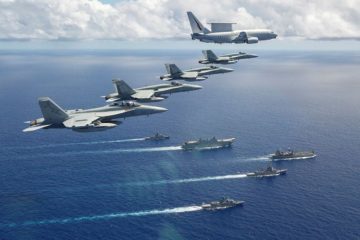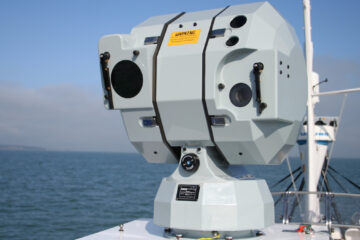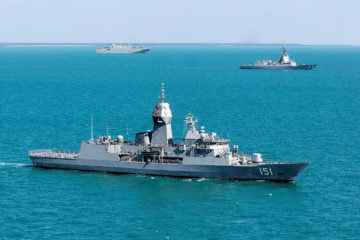The Commanding Officer HMAS Hobart, Captain Ryan Gaskin, said the exercise confirmed the lethality of Australia’s Destroyers, their advanced capabilities and the superior skills of the ships’ crews:
“We have demonstrated through this exercise that our platforms and people are ready to respond to a more complex and contested maritime domain,” Captain Gaskin said. The Aegis Combat System provides the Destroyers with advanced layered offensive and defensive capabilities to counter conventional and asymmetrical threats, while our people provide the expert knowledge that increases our systems’ lethality.”
Commanding Officer HMAS Hobart, Captain Ryan Gaskin
During the exercise, the destroyers also operated with the Royal Australian Air Force (RAAF) F-35A fighters to develop air-sea integration. In addition, Hobart and Brisbane each fired a Standard Missile 2.
Noting the importance of the capability demonstration, the Minister for Defence Industry the Hon Melissa Price embarked in the ships to watch the firings. Minister Price said the cooperative engagement capability allowed shared information and data to be integrated into the ship’s Aegis combat management system:
“Australian workers from both Raytheon Australia and Lockheed Martin Australia Pty Ltd should be proud of their significant contribution to this remarkable capability. Today was a powerful visual milestone for Australian Defence industry after a decade of work across 2700 suppliers who have contributed to the Air Warfare Destroyer Program.”
Minister Price
About Hobart-class Destroyers

The three Hobart-class destroyers Hobart, Brisbane and Sydney are based on the Navantia designed F100 frigate and is coupled it with the Aegis Combat System. They were constructed in Australia by the Air Warfare Destroyer Alliance.
The Hobart-class provides air defence for accompanying ships in addition to land forces and infrastructure in coastal areas, and for self-protection against missiles and aircraft. The Aegis Combat System incorporating the state-of-the-art phased array radar, AN/SPY 1D(V), in combination with the SM-2 missile, will provide an advanced air defence system capable of engaging enemy aircraft and missiles at ranges in excess of 150km.
The Hobart-class ships carry a MH-60R helicopter for surveillance and response to support key warfare areas. The surface warfare function will include long range anti-ship missiles and a naval gun capable of firing extended range munitions in support of land forces.
They also conduct undersea warfare and be equipped with modern sonar systems, decoys, surface-launched torpedoes and an array of effective close-in defensive weapons.
These capabilities ensure that the Hobart-class guided missile destroyers have the layered defensive and offensive capability required to counter conventional and asymmetric threats.
Hobart-class characteristics
- Displacement: 7,000 tonnes full load
- Length: 147.2 metres (483 ft)
- Beam: 18.6 metres (61 ft)
- Draught: 5.17 metres (17.0 ft)
- Speed: 28+ knots
- Range: 5,000 nautical miles at 18 knots
- Complement: 186 + 16 aircrew






